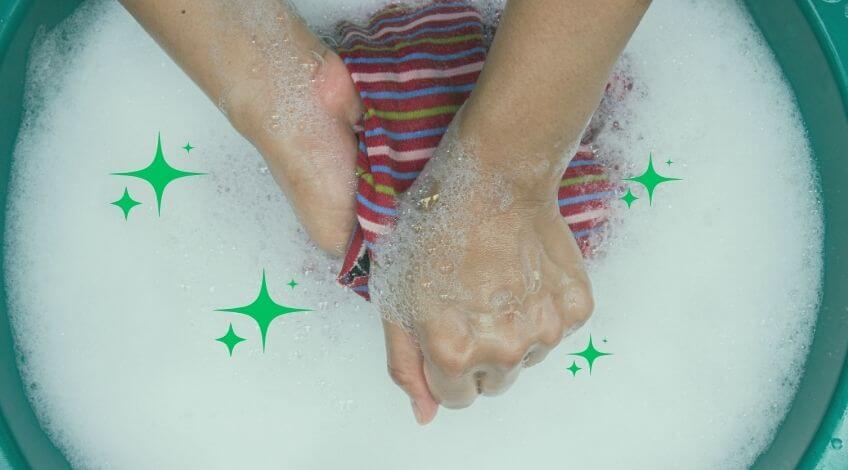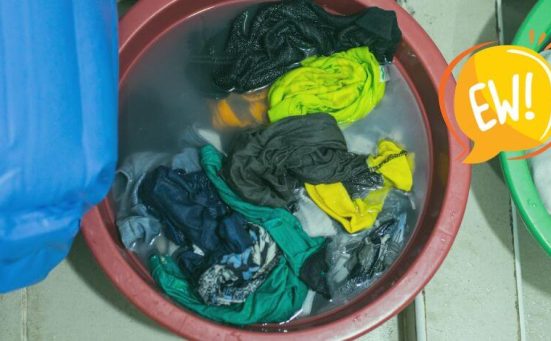
Hand-Washing Your Clothes? Avoid These Easy to Make Mistakes
Staring at a pile of delicate clothes with “hand wash only” labels and feeling a bit overwhelmed? Whether you’re living without a washing machine, trying to extend the life of your favourite garments, or simply wanting to take better care of your investment pieces, hand washing doesn’t have to be a chore that leaves you with disappointing results.
The truth is, most people make simple mistakes that can actually damage their clothes more than a gentle machine cycle would. From using the wrong water temperature to aggressive scrubbing that stretches fibres, these common mistakes can leave your garments looking worse than when you started.
But here’s the good news: once you know what to avoid, hand washing becomes an effective way to keep your clothes looking fresh and lasting longer without the trial and error that wastes time and ruins fabrics.
1. Using Hot Water For Everything
Hot water might seem like the obvious choice for getting clothes clean, but it’s actually one of the fastest ways to ruin delicate fabrics. Hot water causes shrinkage, colour bleeding, and can break down fibres in wool, silk, and synthetic blends.
Cool or lukewarm water is your safest bet for most hand washing. This temperature is gentle enough to preserve fabric integrity whilst still allowing detergent to work effectively. Save yourself the heartbreak of watching your favourite jumper shrink to doll size!
2. Not Testing Water Temperature With Your Hand
That water that feels “just right” from the tap might actually be too warm for delicate fabrics. Your skin can tolerate higher temperatures than many clothing materials, especially natural fibres like wool and silk.
Always test the water with your elbow or wrist, where skin is more sensitive. The water should feel barely warm or cool to touch. If it feels hot in these areas, it’s definitely too hot for your clothes.
3. Ignoring Care Label Temperature Guidelines
Those little symbols on care labels aren’t just suggestions! When a label specifies cold water only, there’s a good reason. Ignoring these guidelines can void warranties on expensive pieces and cause irreversible damage.
Take a moment to decode the symbols before you start. A single dot means cold water (30°C), two dots mean warm (40°C), and three dots mean hot (50°C). When in doubt, always go cooler rather than warmer.
4. Using Regular Washing Powder Instead Of Liquid
Washing powder is designed to dissolve in machine agitation and hot water. When hand washing, powder granules often don’t dissolve completely, leaving residue that can cause fabric irritation and dullness over time.
Liquid detergent dissolves much more easily in cool water and rinses out more thoroughly. Look for gentle formulations like Woolite Delicates or Ecover Delicate, which are specifically designed for hand washing and won’t strip natural fibres of their protective oils.
5. Using Too Much Detergent
More soap doesn’t mean cleaner clothes! Excess detergent is actually harder to rinse out completely, leaving residue that attracts dirt and makes fabrics feel stiff or look dull. This is particularly problematic when you don’t have machine power to help rinse thoroughly.
Use about half the amount you’d normally use in a machine. For a small basin, just a teaspoon of liquid detergent is usually plenty. Remember, you can always wash again if needed, but removing excess soap is much harder.
6. Adding Fabric Softener To Delicate Items
Fabric softener can actually damage delicate fabrics by coating fibres and reducing their natural properties. Wool loses its ability to regulate temperature, silk loses its lustrous sheen, and activewear loses its moisture wicking capabilities.

For a natural alternative that won’t damage fibres, add a splash of white vinegar to your final rinse. This removes any soap residue and leaves clothes feeling soft without chemical coating.
7. Scrubbing And Rubbing Fabric Together
That instinct to scrub stains by rubbing fabric against itself is actually one of the worst things you can do to delicate materials. This friction breaks down fibres, causes pilling, and can create holes in knits.
Instead, gently squeeze and press the fabric in the soapy water. For stains, apply a small amount of detergent directly to the spot and let it sit for a few minutes before gently working it with your fingertips in a dabbing motion.
8. Wringing Out Water Like A Dishcloth
Twisting and wringing delicate fabrics stretches them permanently out of shape. This is especially damaging to knits, which can lose their elasticity and never return to their original size.
Gently squeeze water out by pressing the garment against the side of the basin, or better yet, lay it flat on a clean towel and roll it up to absorb excess water. This protects the fabric structure whilst removing moisture effectively.
9. Soaking Clothes For Hours
Leaving delicate items to soak for extended periods can actually weaken fibres and cause colours to bleed or fade. What starts as good intentions can end up damaging your clothes more than a quick, proper wash would.
Most hand washing only needs 5 to 10 minutes of soaking to loosen dirt and oils. For heavily soiled items, it’s better to wash twice with shorter soaking times than to leave them submerged for hours.
10. Hanging Heavy Knits While Wet
Wet wool and heavy knits can stretch completely out of shape when hung up to dry. The weight of the water pulls the fibres down, creating permanent distortion that makes garments unwearable.
Always lay heavy knits flat to dry on a clean towel or drying rack. Reshape the garment whilst it’s damp to ensure it dries in the correct proportions. This preserves the original fit and prevents stretching.
11. Putting Delicates In Direct Sunlight
That sunny spot by the window might seem perfect for drying, but direct sunlight can fade colours and weaken fibres, especially in silk and wool. UV rays are particularly harsh on dyed fabrics.
Choose a well ventilated area away from direct sunlight. A spare bedroom or bathroom with good airflow works perfectly. If you must dry outside, choose a shaded spot and bring items in as soon as they’re dry.
12. Not Removing Excess Water Before Drying
Clothes that are dripping wet take much longer to dry and are more prone to developing musty odours or mildew. This extended drying time can also cause colours to bleed onto themselves.
After gently squeezing out water, lay the garment on a dry towel and roll it up to absorb additional moisture. Then reshape and lay flat on a fresh, dry surface. This speeds up drying time and prevents moisture related problems.
13. Not Spot Treating Stains First
Jumping straight into washing without addressing stains first often sets them permanently into the fabric. Once a stain goes through a wash cycle, it becomes much harder to remove and may become a permanent feature.
Apply a small amount of liquid detergent directly to stains and let it sit for 5 to 10 minutes before washing. For oil based stains, a dab of washing up liquid works brilliantly. Always test any treatment on a hidden area first.
14. Washing Different Colours Together
Even in cool water, some dyes can still bleed enough to tint other garments. This is particularly risky with new items or anything red, which tends to be the worst culprit for colour transfer.

Wash similar colours together, and always wash new items separately for the first few washes. When in doubt, use a colour catcher sheet or wash items individually to protect your investment pieces.
Your Hand Washing Success Strategy
Hand washing doesn’t have to be complicated or risky when you avoid these common mistakes. The key is being gentle, patient, and using the right techniques for each type of fabric.
Remember that hand washing is often gentler on clothes than machine washing when done correctly. You have complete control over the process, which means you can give special attention to delicate areas and ensure thorough but gentle cleaning.
Most importantly, don’t rush the process. Taking a few extra minutes to do it properly will extend the life of your clothes significantly, saving you money and keeping your favourite pieces looking their best for years to come.
Next time you’re faced with a pile of delicate washing, you’ll have the confidence to tackle it properly. Your clothes will thank you for the extra care, and you’ll be amazed at how much longer they last when treated with the right techniques.
Share these tips with anyone else who’s struggled with hand washing disasters. After all, we could all use help keeping our favourite clothes looking fabulous!
SEE ALSO: Your Home Could Look Cleaner Instantly If You Ditch These Paint Shades!
Also, follow us on Pinterest ...



